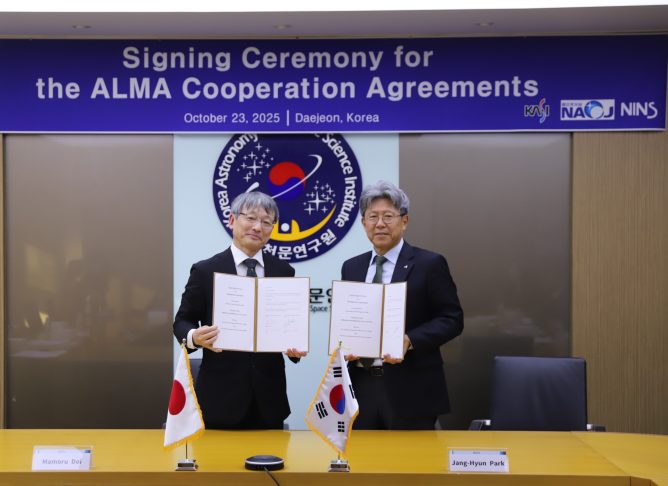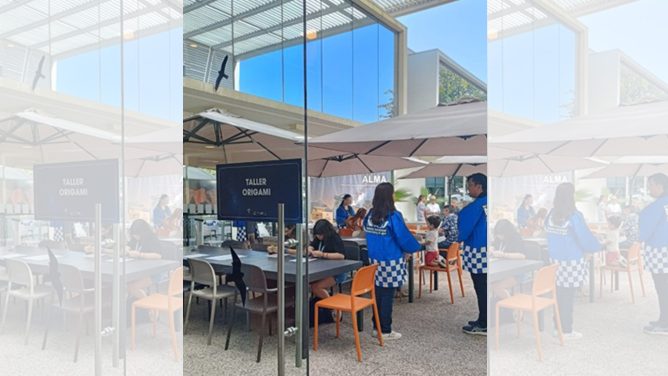On Sunday, February 2, the NAOJ Public Talk/the 24th ALMA Public Talk was held at the Tokyo International Exchange Center (TIEC) in Koto, Tokyo. The talk event titled “Formation and Evolution of Galaxies Explored by ALMA” covered a wide range of topics from the overview of galactic research with ALMA to the latest scientific results on distant galaxies and nearby galaxies inviting specialists of the respective fields.
In the question-and-answer session after the talk, the audience asked various questions like: “Why is it necessary to detect oxygen? “What is the new picture of the early universe revealed in recent competing observations of distant galaxies?” and so on. In a pleasant atmosphere, a lively dialogue was held between the audience and researchers.
Talk 1. Detecting “Shadow Ruler” through Radio Observation by Koichiro Nakanishi (Project Associate Professor at NAOJ)
The first talk started from the introduction of the overall picture of galactic research with ALMA. The speaker posed a question, “Who is the “Shadow Ruler” of galaxies?” The audience was guided to investigate the answer while overviewing the features of various galaxies. While the birth of stars is an important process for the formation and development of galaxies, what forms stars is interstellar gas and dust. ALMA can receive radio signals from such invisible gas and dust. The speaker talked about how ALMA observations are carried out, showing pictures of the ALMA antenna site in Chile and workplaces of researchers, and furthermore he explained the images of newly detected galaxies and what is important in examining the quantity and quality of gas, showing a radio catalog of galaxies captured by ALMA.
Talk 2. What Does ALMA See in Galaxies? -Ingredients of Stars Hidden in Molecules – by Tomoka Tosaki (Professor at Joetsu University of Education)
Professor Tosaki has been engaged in observational research of galaxies focused on various kinds of molecules, while teaching astronomy and other scientific subjects to undergraduate students who aim to be a teacher. The speaker began her talk from an astonishing difference of scale of the universe stating there is a 30-digit difference in the size of a molecule and a galaxy. The talk was sprinkled with joy in her research work and many examples of enormous differences on cosmic scale. The speaker also shared recent observation results obtained with the highest-resolution radio telescope ALMA, which has revealed the existence of various molecules that give important clues to the diversity of galaxies. The audience looked greatly impressed by the talk of a researcher on the front line who has been enjoyably exploring an increasing number of mysteries of the universe along with new discoveries made by leading-edge observing instruments.
Talk 3. In Search of the First Galaxy- Endeavor with ALMA- by Akio Inoue (Professor at Waseda University)
Inoue is specialized in observational astrophysics. The research group led by Inoue has been making worlds’ leading achievements in the field of research on the most distant galaxies, which includes the discovery of oxygen in a galaxy 13.28 billion light years away. While mentioning the key concept “red shift”(a phenomenon where the wavelength of radio waves is stretched by cosmic expansion), the speaker shared with the audience how his team has been making progress in worldwide competition in search of the most distant objects (the closest objects to the beginning of the universe), making a vivid analogy of competing vigorously with rivals in sports. The talk also covered the future perspective of ALMA operations in collaboration with the next-generation telescope under discussion.
Our understanding of distant galaxies has been drastically reshaped by recent discoveries made by ALMA that detected oxygen and carbon in galaxies further away than13 billion light years. Along with these findings, there has also been remarkable progress in the research of nearby galaxies with newly-captured, high-resolution images of molecular clouds (reservoirs of star-forming ingredients) which correlated the star formation studies inside and outside the Milky Way Galaxy.
You can find the video of this public talk event on YouTube.










